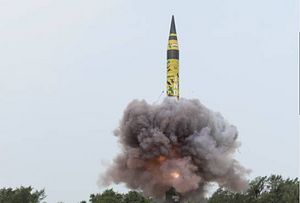The Indian Ministry of Defense (MoD) is expected to officially induct its most advanced nuclear-capable intercontinental-range ballistic missile (ICBM), the Agni-V, in December, according to local media reports.
The Agni-V, a three-stage ICBM officially designated by the MoD as an intermediate range ballistic missile (IRBM), is expected to undergo one more pre-induction test in the fall. The missile was last test fired from a mobile launcher from the Integrated Test Range on Abdul Kalam island in the Bay of Bengal off the coast of the eastern Indian state of Odisha in June.
It was reportedly the sixth successful test of the Agni-V ICBM. Previous tests occurred in January 2018, December 2016, January 2015, September 2013, and April 2012. Whereas, the June and January as well as the January 2015 tests involved Agni-V ICBMs in deliverable configuration launched from sealed canisters, other missile tests had the Agni-V in ‘open configuration.’
An operational deployment of the Agni-V ICBM–designed to provide India with a second-strike capability–would require at least two additional test launches (user trials) by India’s Strategic Forces Command (SFC). Development of the Agni-V kicked off in 2008. The missile features indigenously designed navigation and guidance systems including a ring laser gyroscope based inertial navigation system.
As I noted previously:
The Agni-V, a three-stage solid fueled missile, has an approximate range of 5,500-5,800 kilometers [the exact range remains classified, but it is assumed that the missile has a range of 6,000-7,500 kilometers], and can carry a 1,500-kilogram (3,300-pound) nuclear warhead. India has reportedly also been working on multiple independently targetable reentry vehicles (MIRV) for the Agni-V in order to ensure a credible second-strike capability.
Furthermore, I wrote:
While previous nuclear-capable missiles of the series (Agni-I, Agni-II, and Agni-III) were developed to offset Pakistan’s nuclear arsenal, the Agni-IV, [and] Agni-V (…) given their longer ranges, are designed to provide a credible nuclear deterrent against China.
India’s Defense Research and Development Organization has also been working on a next-generation ICBM, the Agni-VI, a four-stage ICBM with multiple independently targetable reentry vehicle (MIRV) and maneuverable reentry vehicle (MaRV) capability with an estimated range of over 10,000 kilometers. As I further explained elsewhere in these pages:
Both the Agni-V and Agni-VI will feature increased accuracy and a reduced launch time, which, paired with India’s burgeoning MaRV and MIRV capability, can have a destabilizing effect on the overall strategic balance in the region.
Notably, India has a No First Use (NFU) policy for nuclear weapon and keeps its nuclear warheads de-mated from the actual missiles.

































